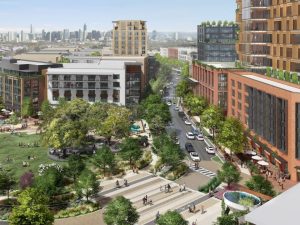3.1 MSF Shopping Center Conversion Project Advances
The Austin Planning Commission approved a proposal to redevelop the site as a mixed-use destination.
Lionstone Investments and Barshop & Oles Co. have surpassed a notable hurdle in their bid to convert the Brodie Oaks Shopping Center in Austin, Texas, into an innovative, 3.1 million-square-foot mixed-use destination. The Austin Planning Commission voted in favor of recommending the development partners’ rezoning request, with a few stipulations, as first reported by the Austin Business Journal.
Paying homage to the property’s history, Lionstone and Barshop have named the redevelopment Brodie. The partners have a grand vision for the retail property fronting Loop 360, and the rezoning of the site to a planned unit development is a necessity. The 365,000-square-foot Brodie Oaks, which debuted in 1982, will be replaced with multiple structures of varying heights and vast open space spanning the site’s 38 acres.
“Not only for Brodie but for most redevelopments, mixed-use allows for the highest and best use of a commercial site,” Milo Burdette, partner & vice president of development with Barshop & Oles Co., told Commercial Property Executive. “Providing transit-supportive mixed-use density will allow Brodie to be a community where people can work, live and play, lessening the miles traveled on public roadways and activating Brodie as a destination for South and Southwest Austin.”
READ ALSO: NAREE Report: Retail Real Estate’s Post-COVID Reinvention
Brodie is a well-conceived project; the master plan for the redevelopment began to develop in 2019 and reached a final state in 2020. At full build-out, the mixed-use property will feature more than 1.2 million square feet of office space; 1,700 multifamily units, including affordable housing, spanning a total of 1.5 million square feet; 140,000 square feet of retail and dining offerings and a 200-key hotel that will total 200,000 square feet.
The demand for housing is strong in fast-growing Austin, but the call for office space is less robust. Overall, the U.S. office market has not fully recovered from the ravages of the pandemic and Austin is no exception, but Barshop and Lionstone see a void that Brodie can fill.
“Brodie’s proximity and easy access to downtown, Austin-Bergstrom airport and numerous South and Southwest neighborhoods make it attractive to all types of office users. Many larger users are finding that it makes sense to have a presence in multiple areas of Austin to provide better access for their employees. Downtown and North Austin have many alternatives, but the options for South and Southeast Austin are more limited. Brodie will be able to fulfill some of that demand.”
The redevelopment endeavor will also be green to the core, featuring approximately 14 acres of open space, representing 45 percent of the project. An additional 8 acres will serve as a naturally vegetated buffer. Furthermore, 100 percent of the water quality volume at the property will utilize green stormwater controls, including irrigation, retention and infiltration. The transit-oriented redevelopment will also offer bicycle facilities and a shared-use bike path linked to off-site trails.
Next on the developers’ checklist is a City Council first reading, scheduled for December 1, 2022. If all goes as planned, the partners will finalize the Brodie design in 2023. Delivery of the project’s initial phase is expected in 2027.
Thumbs up from the public
Brodie Oaks Shopping Center has been around long enough to have its diehard fans, but plenty of locals see the benefit of a mixed-use project and embrace Barshop and Lionstone’s idea for the property.
“The existing ocean of parking, collection of empty big boxes, greatest hits of 1980s strip mall architecture is a gross underutilization of the site that maximized impervious cover and turned its back on some of the best views in Austin,” a longtime resident of the area’s South Lamar neighborhood wrote in a letter to the Austin Planning Commission. “In contrast, the Brodie project as envisioned by the development team strikes all the right notes: it decreases impervious cover, provides an inviting connection to the greenbelt, takes advantage of the gorgeous views, includes affordable spaces for creatives and housing, aligns with existing and future transit, and activates the site with a variety of uses for 24/7 engagement.”
The mall as a mixed-use destination is an increasingly popular concept. Earlier this week, the Phoenix City Council signed off on the planned $750 million redevelopment of the historic Metrocenter Mall into a mixed-use district to be known as The Village.
Ultimately, Brodie could carry an overall development price tag of approximately $1.5 billion; however, Burdette noted, future design and market conditions will determine the final figures.








You must be logged in to post a comment.